| 1 | Green tree python |
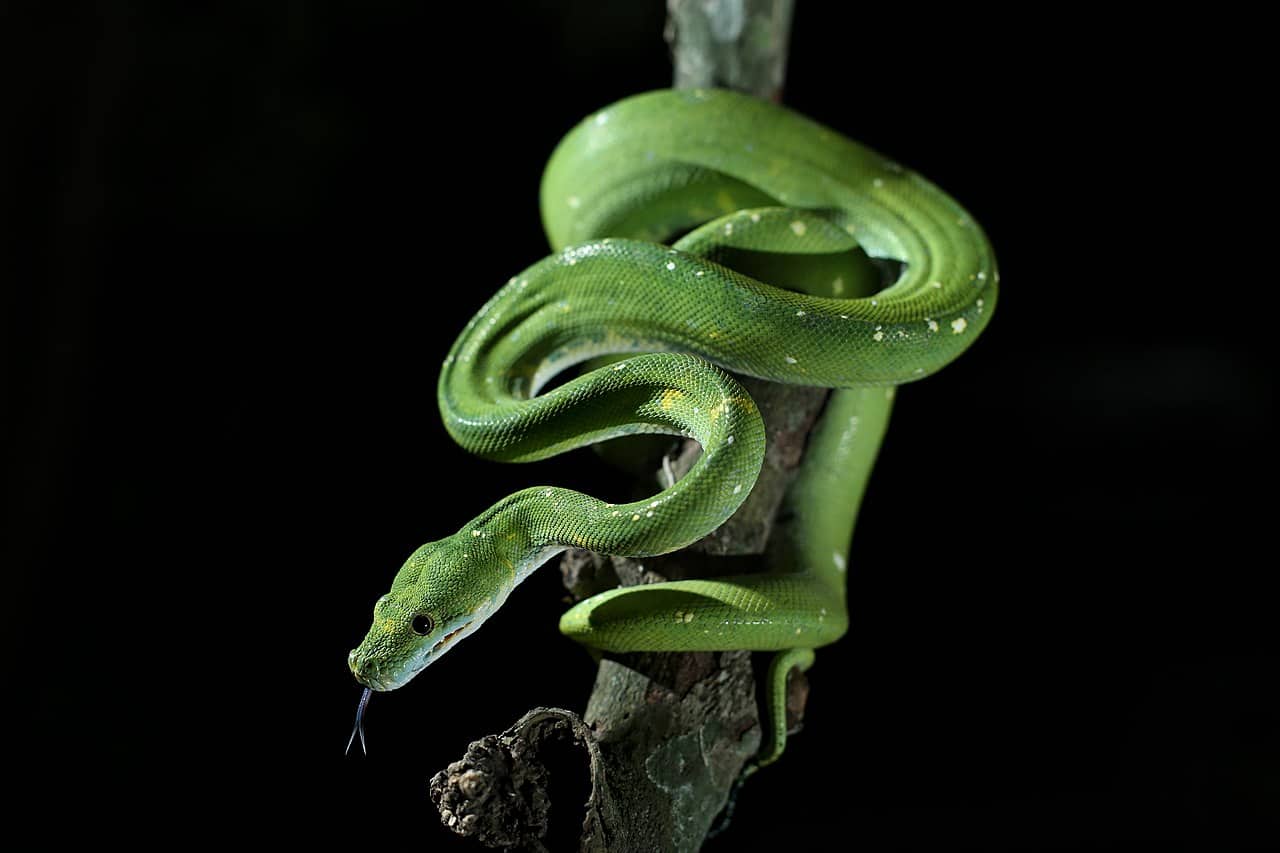
An ontogenetic colour transformation is simply a change in colour from juveniles/newborns to adults within a species. This is found in several snakes worldwide, but none can compare with the green tree python (Morelia viridis), a 1.8 metre Australian rainforest snake. This species dwells in Queensland and New Guinea, where it clings to branches in ambush posture virtually all day. They rarely stray to the ground, and can reach branch perches 25 metres high.
Youths have a very different lifestyle, sticking to the ground, and their colour is also completely different. Instead of fully rainforest green, they’re a bright lemon yellow, overlaid with subtle dark bands. There isn’t a trace of green on their body at birth.
The transformation usually kicks off at 12 months, and at lengths of 53-59cm. Scale by scale, green will appear from nowhere to replace yellow. Suddenly, this accelerates, so that within just 8-10 days, the yellow Morelia viridis has become completely green. This transformation takes place with no skin shedding. At this point, wild green tree pythons ascend to the tree branches and never look back.
Green tree pythons are popular in captivity worldwide, due to their sedentary nature. Many keepers have been struck with awe as the gradual colour change kicks in unannounced. On Biak Island, Papua, there’s also a rare population which begins life as brick red. These then pass through the yellow phase, and finally onto green.
| 2 | Clelia clelia |
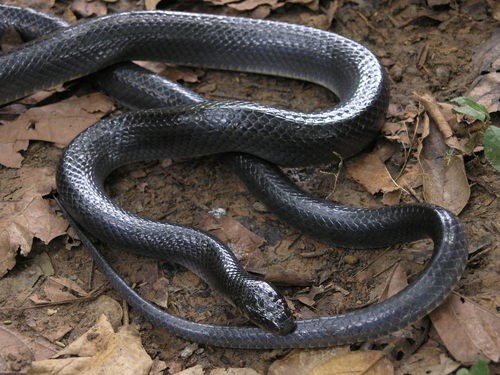
This snake-eating snake looks so different as a juvenile that local villagers fail to realise that it’s the same species. Clelia clelia is South America’s most ophiophagous snake, preferentially feeding on venomous pitvipers. Confirmed prey include the fer-de-lance, eyelash viper and South American bushmaster, with 17 snake species known in their diet.
As an adult, Clelia clelia is an oily blue-black with few patterns. As a juvenile, they’re a bright red, with a black head seperated by a white or yellow neck collar. Locals view the juvenile form as a “blood snake”, which triggers uncontrollable haemorrhaging on every inch of your body (its venom is actually mild).
The reason for the difference is unknown, as both adults and juveniles dwell on the ground, and prefer evergreen forests with a leafy bottom. The transformation begins when individuals reach 70-75cm. Rather than random blotches suddenly manifesting, the tip of each scale gains a small black pigment. This spreads and spreads, until black totally displaces the red, usually at 3-4 years. The black head stays identical, and the yellow/white neck collar is always the last to fade. Fully black young adults can be found with lingering traces of the pale collar.
| 3 | Green catsnake |
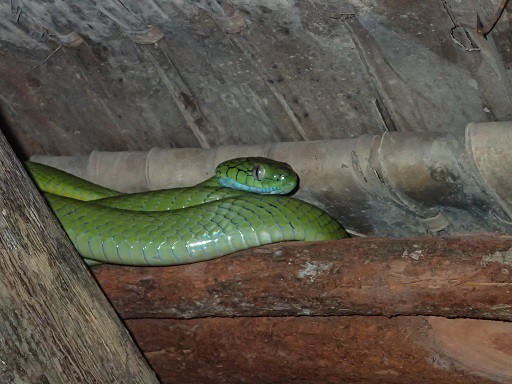
Another bright green snake which begins life as a totally different colour. Green catsnakes (Boiga cyanea) are branch-dwellers like the green tree python, but stick to lower levels of 2-3 metres, rather than towering canopies. This species is most common in Thailand, where they’re regularly mistaken for white-lipped pitvipers, and are a top nest raider of birds. While they possess a mild neurotoxic venom, they’re too weak to affect humans.
Green catsnakes lay clutches of 3-10 eggs, which are pill-shaped and snowy white in colour. After hacking their way free and slithering out into a Thai forest in a state of mild confusion, juvenile green catsnakes are almost completely brown, with the exception of a bright green head. The brown and green contrast vividly, and their eyes are especially bulging as hatchlings.
For several months, this elixir of greenness will be contained within their head, within strict boundaries. Eventually, the green begins to spread inch by inch. Over the coming weeks, it grows to cover the green catsnake’s entire body. By adulthood, all traces of brown are eliminated, and a true green catsnake is born. Adults sometimes have speckles of blue as well, particularly around the throat.
Unlike green tree pythons, Boiga cyanea dwells on branches as a juvenile as well, so the shift in colour has a less obvious explanation. Bonus: here’s a picture of a green catsnake resting directly on a “beware of snakes” sign.
| 4 | Wagler’s sipo |
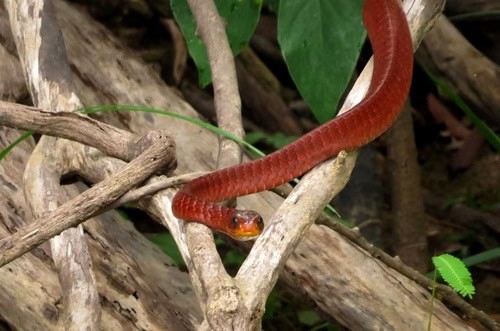
The rule is that snakes which begin life on the ground then ascend to the branches typically blossom into green, like the green tree python. However, the reverse can also happen. The Chironius sipo family has 23 members in South America, and while all are decent climbers in adulthood, they become far less reliant on branches with age. Every member of this family undergoes an ontogenetic colour change, with the exception of Chironius flavolineatus, AKA Boettger’s sipo.
Wagler’s sipo (Chironius scurrula) is one of the most dramatic transformers. This species is found across virtually the entire Amazon region, with a particular concentration of sightings in eastern Ecuador and Suriname. They measure 150-180cm, peak at 224.3cm, and primarily prey on frogs. At birth, Wagler’s sipos are a bright pastel green, with no complex patterns, just a jungle leafiness. With age, the green gradually retreats, and is replaced with red.
Some adults are a plainer rusty red, while others look like a sea of molten magma, with melting chunks of earth flowing through a fiery sea. How spectacular they are depends on the individual. Wagler’s sipo barely has a presence in captivity worldwide, and would probably fare poorly given their active, energetic nature.
| 5 | Mexican cantil |
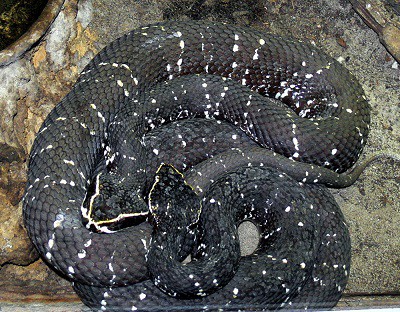
Mexican cantils belong to the same Agkistrodon family as copperheads and cottonmouths, but are found exclusively in Mexico, in dry thorny forests, as opposed to open deserts. Mexican cantils are thick, stocky ambush predators which reach a maximum of 141cm. Of their family, they easily have the most memorable colours. They’re almost pure black, with thin white lines and speckles of white shining through. Their goal is presumably to blend into gloomy nocturnal forests, as they hunt their nighttime prey.
As juveniles, their patterns are much browner and less striking. The white remains, while the black is in similar spots, but filled in with more typical brown. They also have a bright green tail, used for caudal luring. As the years go on, Mexican cantils grow darker and darker, until only the snout has a hint of brown.
However, they must be patient to achieve this change. If they do their time in the dry thorny forests of Mexico, dodging swooping hawks, aggressive coral snakes and greedy human poachers, then they will be blessed with the sleek black-white colours reminiscent of a starry night that all species members have.
| 6 | Side-striped palm pitviper |
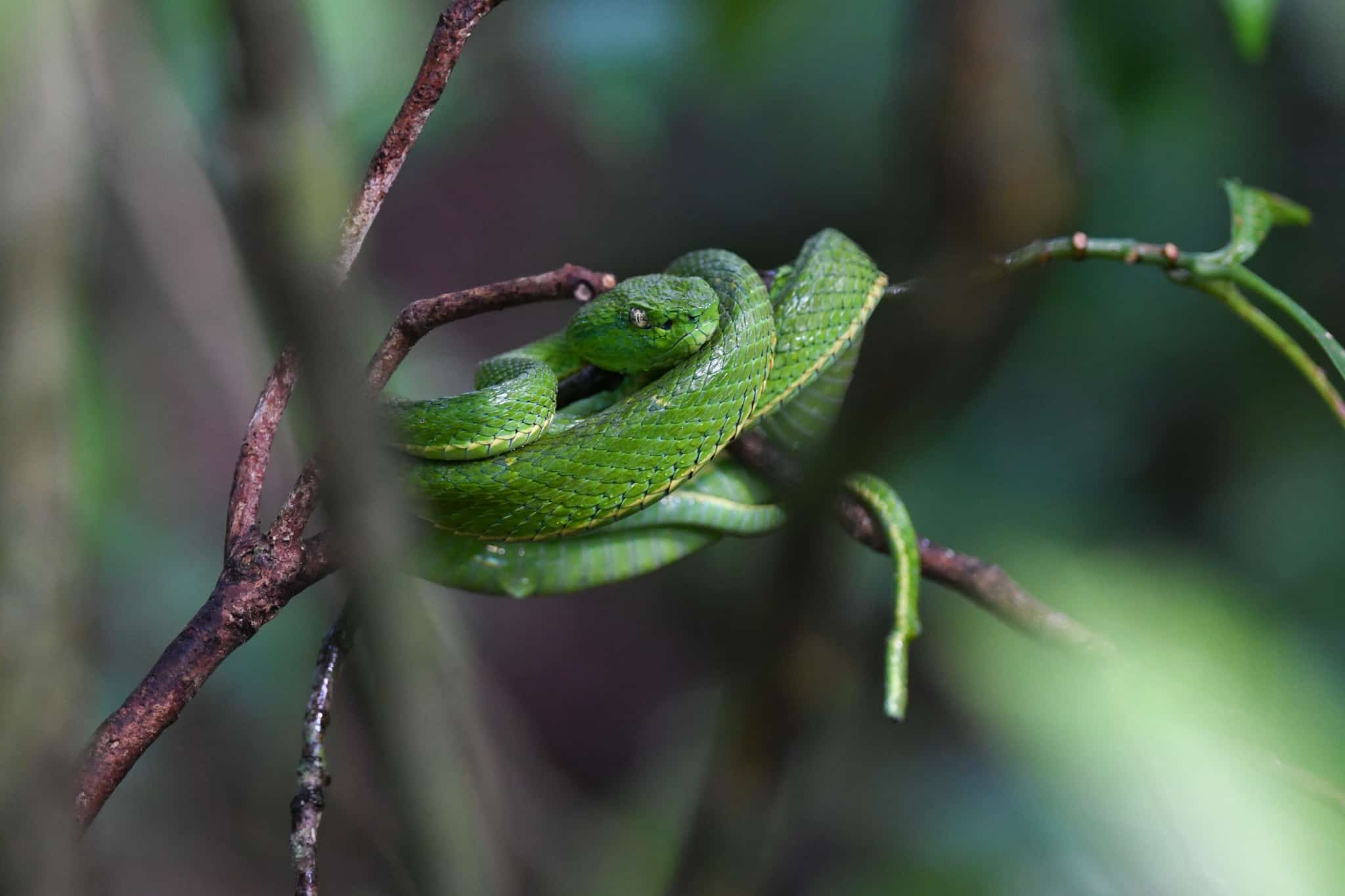
A branch-dwelling pitviper of Costa Rican mountains, where they dwell at 850-2100 metres above sea level. Bothriechis lateralis also dwells in Panama, though is less common there. This species has a haemorrhagic venom and reaches a maximum of 100cm.
The side-striped palm pitviper undergoes a complete transformation from brown to green in adulthood. Within the species, Bothriechis lateralis has virtually no morphs, with most individuals having similar green colours, but age is the sole exception. All juveniles are brown, with a thin, pale line on the lower flanks on each side. The brown is overlaid with occasional darker brown blotches, with a slight white border. Into adulthood, the thin white lines on the flanks remain. But everything else transforms, as Bothriechis lateralis becomes completely green, and the small markings become purely white.
The Bothriechis pitviper family has over a dozen members (e.g. the eyelash viper), but none have as strict a transformation as this. Most are equally green as juveniles, and the only real competitor is Bothriechis guifarroi in northern Honduras. This is always green in adulthood, and younglings have two separate morphs, with 50% being green and another 50% brown.
| 7 | Large whipsnake |
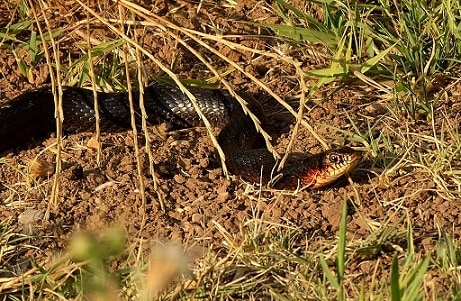
If you see a huge black snake slithering through an olive grove in Israel, it’s almost certainly the large whipsnake. This species is found in shrubland and coastal Mediterranean landscapes rather than arid deserts, and is wary of humans, launching aggressive assaults if restricted in any way.
Large whipsnakes (Dolichophis jugularis) reach a maximum of 250cm and average at 160-180cm. Israel’s countryside has an abundance of pure black snakes, which are easily confusable, but no others reach such large lengths, making this snake easily recognisable. There’s one catch though: their patterns and colours are completely different as a juvenile.
Young large whipsnakes have a beige or tan base, overlaid with many tiny dark markings, often with red interiors. Their face is extremely messy, with many black lines. As they age, the forces of darkness spread, and large whipsnakes grow blacker and blacker, destroying all remnants of patterns.
As an adult, the only exceptions to their black colour are their face, which has creamy sections and a red chin. Many also have a golden yellow iris. But some seem to be completely black.
| 8 | Great Lakes bush viper |
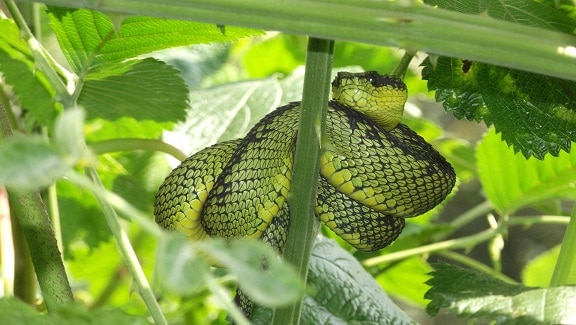
This venomous species is a favourite of reptile keepers, although they’re rare in captivity, mainly because they’re rare worldwide. Great Lakes bush vipers (Atheris nitschei) are found exclusively on the border regions of Uganda, Burundi, Rwanda and DRC. They live at altitudes of 1600-2800 metres, where they cling to branches for much of the day, with a preference for swampy regions.
Atheris nitschei is popular for its bright green scales, overlaid with sharply contrasting black patterns. This comes in thick black spinal zigzags, with many isolated black blotches on their sides, plus a wide black eye streak.
But in their youth, none of this exists. Instead, Atheris nitschei is a dull, tree trunk brown, without a speck of the green which will later come to dominate. The only pale section of their body is their tail, which is pale yellow. The purpose is caudal luring, wiggling it in a slow, rhythmical pattern to lure in curious frogs, and then devour them. This is the only advantage youths have over adults in their colours. Adult Great Lakes bush vipers are much more colourful, but youths have an extra hunting strategy.
| 9 | Madagascan tree boa |
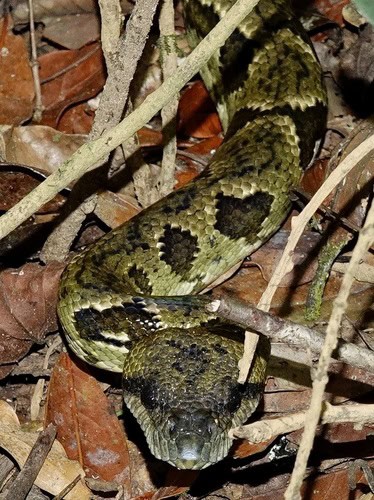
The third longest boa on Madagascar, at a record of 213cm. Madagascan tree boas are shorter than the ground boa or Dumeril’s boa, but have heat-sensing facial pits which those neighbours lack. Madagascan tree boas (Sanzinia madagascariensis) inhabit the north and east of Madagascar, usually in forested areas close to streams or marshes, occasionally backgardens. Despite their name, this species tends to sleep on branches while coiled up during daylight, and hunt on the ground during night.
At birth, this constrictor is a bright red-brown colour, with hourglass shaped black blotches (with a little yellow representing sand). This is speculated to be for blending with colourful treetop flowers. At approximately 8 months, and following 4 skin sloughs, Madagascan tree boas begin to gain their adult colours: green. The dark blotches remain, and their body only grows more thick and crushing.
Unlike other tree snakes, however, they never become a bright pastel green. With the Madagascan tree boa, it’s more like a thick layer of moss that grows gradually over their bodies, coating their scales with a funky green fur, with a base of black still visible below. This species has all the boa features you’d expect: vertical pupils and a hungry, prehistoric-looking skull.
| 10 | Bibron’s coral snake |
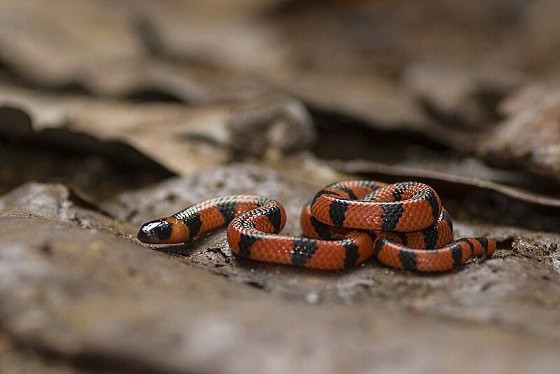
This rare, dangerously venomous species is found only in the Western Ghats mountain range of southwest India. Bibron’s coral snakes are non-aggressive, and likely only bite human beings if manhandled. Envenomations are so rare that their effects are unknown, though they’re presumed to be neurotoxic and paralysing like their Malaysian blue coral cousin.
What is known is that Bibron’s coral snake undergoes a strong transformation in colour with age. In their youth, they’re bright banded, with a red base overlaid with pure black or dark brown. These bands cover the body from head to tail, and number as many as 36.
With age, the red sections gradually darken, leading their body to become purely black, with slight red tinges, with the flanks holding out for longer. At all ages, the black tends to mask their face, so that their eyes are barely distinguishable. Bibron’s coral snakes reach a maximum of 88cm (a male), and this study found that the darkening process began at lengths of 35-45cm (excluding the tail).
This species has particularly small eyes, with a diameter of just 1.45mm. This picture shows a Bibron’s coral snake mid-transformation. The black bands are constant, but the red are in crisis mode, with black speckles popping up like moles.
